Art Nouveau jewelry
38 Products
-
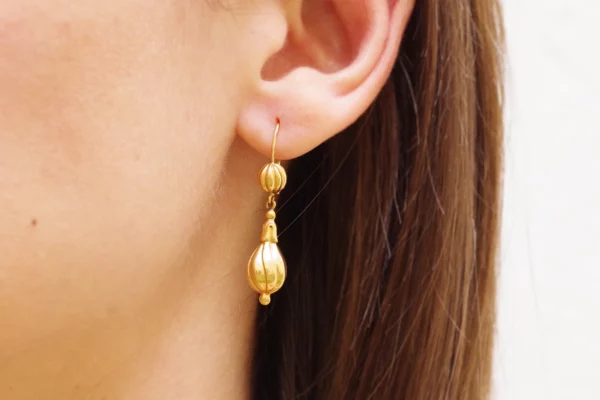
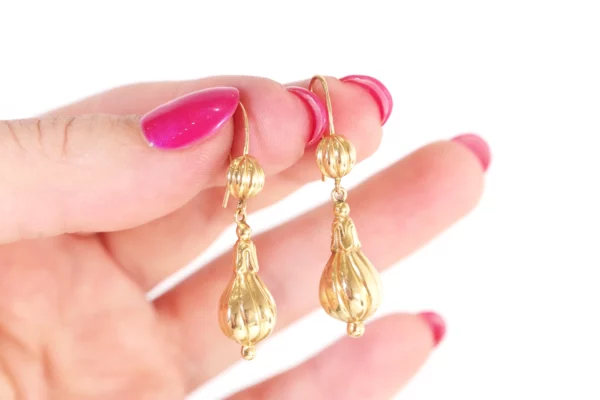 660,00€
660,00€French fileuses long earrings in 18 karat gold. Antique earrings with spherical gadrooned motifs holding a tassel of the same design. Antique earrings, early 20th century, France.
Eagle head hallmark (french state hallmark for 18 karat gold) and goldsmith’s hallmark.
Height: 37 mm
Width: 9 mmCondition: fine wear scratches
Weight : 1.83 gr
-
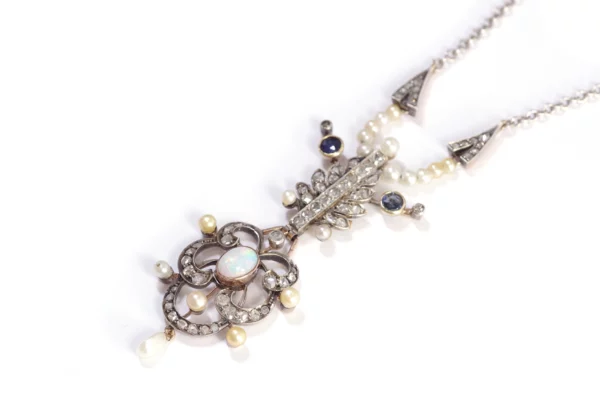
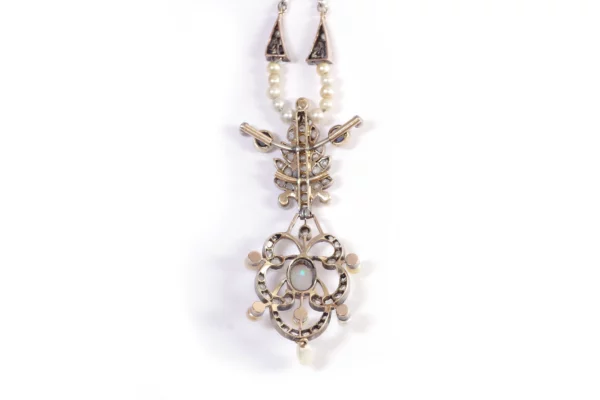 1100,00€
1100,00€Opal diamond pendant necklace in 9 karat gold and silver. Antique pendant composed of various floral elements set with 65 rose-cut diamonds, fine pearls and sapphires. An opal cabochon adorns the lower part of the pendant. Two natural round sapphires adorn the upper part of the jewel. Silver chain and round clasp. Belle Époque necklace, circa 1895.
Clover and swan hallmarks
Chain length: 50 cm
Height: 75 mm
Width: 24 mmEstimated sapphire weight: 0.18 carat
Estimated opal weight : 0.67 carat
Estimated diamond weight : 0.30 caratCondition: scratches from use
Weight : 12.18 gr
-
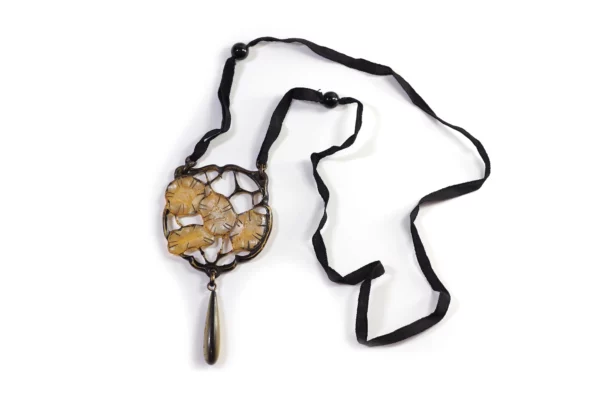
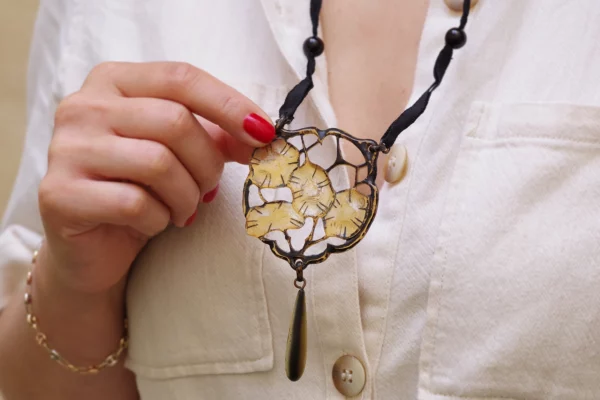 1500,00€
1500,00€George Pierre Art Nouveau necklace in horn. Long Art Nouveau necklace in carved blond horn, embellished with black and ochre inks, in the shape of annual honesty plant. The pendant holds a blond horn tassel also colored black and ochre. The necklace is made of black silk ribbon decorated with two black glass beads. Art Nouveau necklace by Georges Pierre dit “GIP”, circa 1910, France.
Signed on the reverse GIP for Georges Pierre
Length: 72 cm
Design dimensions: 16 x 59 mmCondition: paint missing, scratches from use
Weight : 14.75 gr
More details : Slices of horn were dipped in hydrogen peroxide to make them translucent, then bathed in chemicals to give a shimmering sheen to the wings or a rosy sheen to the petals. The pendants, sculpted and dyed with inks, were mounted on silk ribbons, cords or chains with pastel glass beads repeating the delicate hues. Elisabeth Bonté and Georges Pierre G.I.P., initially rivals, pooled their resources and talents before producing horn jewelry until 1936, when Bakelite became the preferred material for costume jewelry.
-
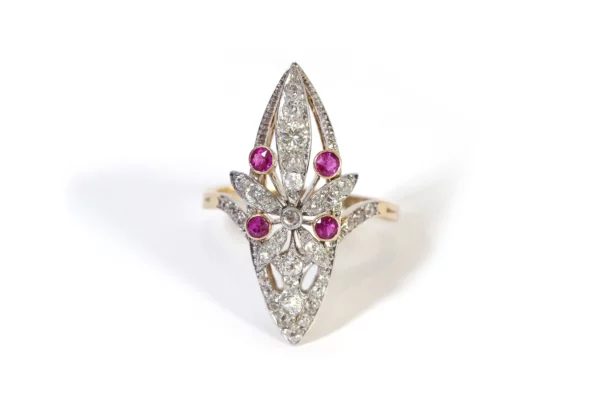
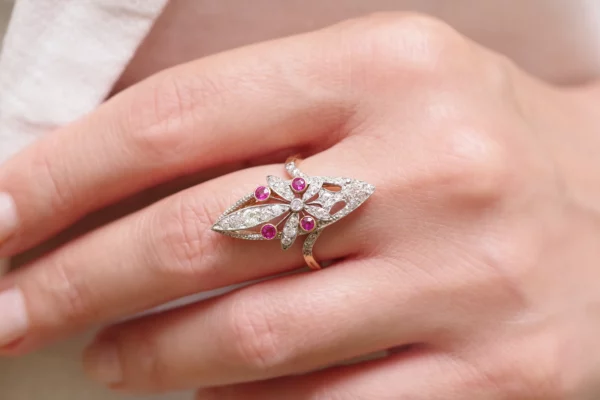 1900,00€
1900,00€Belle Époque marquise ruby diamond ring in 18 karats (750) gold and platinum. Belle Époque ring, dating from the early 20th century, entirely set with diamonds of various cuts (old mine cut, rose cut, brilliant cut) and four round synthetic rubies. The ring has a total of 36 diamonds. The stones form a flower motif, with a long petal extending over the finger. Edwardian ring, circa 1900.
Owl and mask hallmark (french state hallmark for 18 karat gold)
Finger size : 57 UE or 7.75 US ( possible to resized)
Estimated total diamond weight: 0.34 carat
Estimated weight of synthetic rubies: 0.10 caratKitten size: 3 cm
Condition: fine wear scratches, old setting, uneven diamond cuts.
Weight : 5.14 gr
-
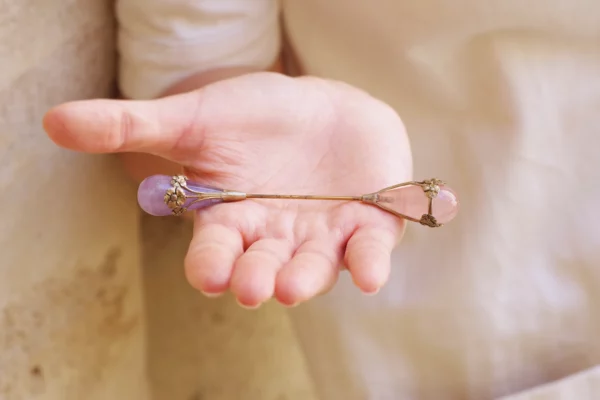
 560,00€
560,00€Art Nouveau double hair pin in silver. Art Nouveau pin composed of a rose quartz and a violet quartz (amethyst) in drop form, placed on either side of a silver stem. Both crystals are encircled by silver flowers. This important pin was most likely used to adorn a hairstyle, such as a chignon. Antique double pin, Art Nouveau period, circa 1900, France.
Boar hallmark (french state hallmark for 18 karat gold) and goldsmith’s hallmark.
Length: 12 cm
Quartz dimensions: 3 x 1.5 cmNote: one end screws onto the stem
Condition: crack on one quartzWeight : 24.03 gr
-
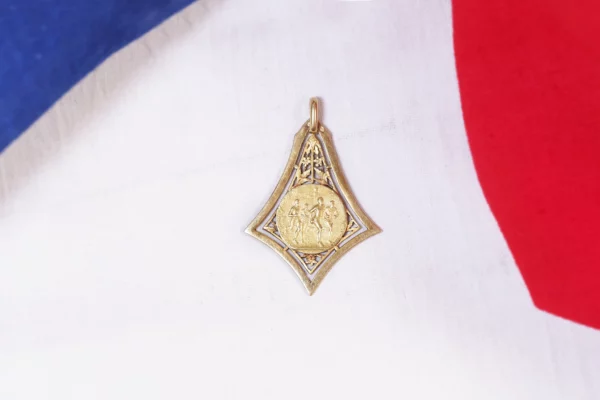
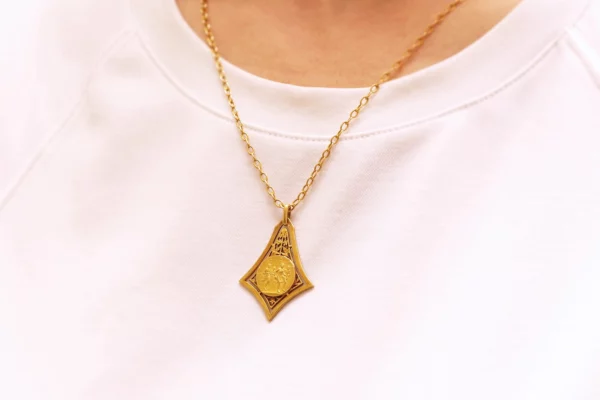 700,00€
700,00€Art Nouveau Athletics medal in 18 karat yellow gold. Art Nouveau pendant centered on a small medal depicting four runners in a 4×1200 meters relay race. The pendant is openwork and decorated with flowers and foliage, typical of the Art Nouveau period. The reverse of the medal bears the inscription “L’intransigeant 17 Dec 1922 Relais 4×1200”. Sports medal pendant, 1922, France. Sport jewelry collection.
Hallmark: eagle’s head and illegible maker’s mark, medallist’s signature H. DEMEY
Height (including bail): 4 cm
Width: 2.7 cmCondition: signs of wear
Weight: 6.12 gr
*The antique gold chain is not sold with the jewel*
See our antique chainsMore information : This piece was awarded to Armand Burtin for the cross-country race of L’Intransigeant held on December 17, 1922.
Armand Burtin (1896-1972) was a French athlete specializing in running (1500 meters, relay, 3000 meters). He left a significant mark on French athletics history with his remarkable performances. In 1920, Armand Burtin won the French Championship title in the 1500 meters, crossing the finish line in 4 minutes and 3.4 seconds. This victory etched his name in French athletics history and demonstrated his exceptional talent in this discipline. Armand Burtin represented France in the Summer Olympics of 1920 and 1924, proudly bearing his country’s colors on the international stage. His sporting career and achievements left a lasting legacy in French athletics, making him a respected and admired athlete both for his track performances and his dedication to the sport.
-
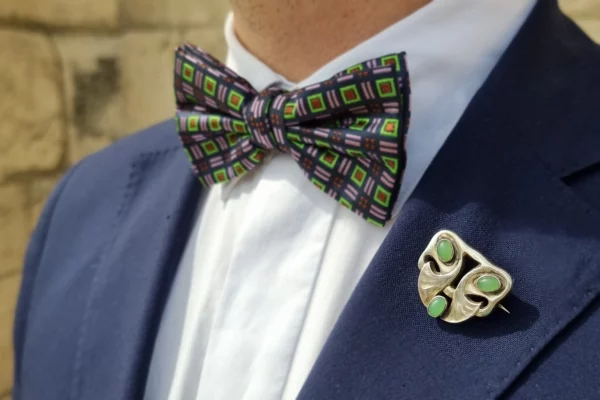
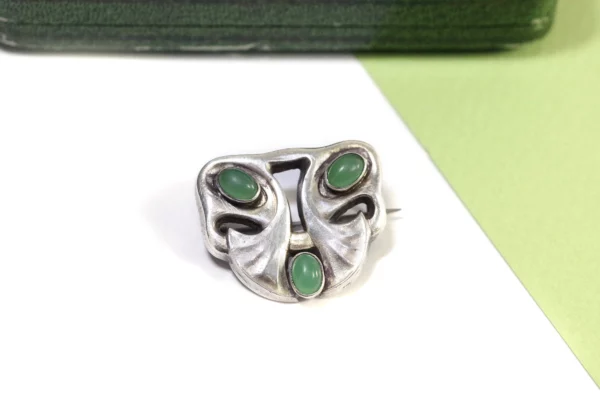 490,00€
490,00€Jugendstil silver brooch. Brooch in silver set with light green glass cabochons. Art Nouveau brooch, Jugendstil period, circa 1900, School of Pforzheim, Germany.
Registered hallmark and weevil hallmark.
Dimensions: 30 x 25 mm
Condition: scratches from use
Weight : 7.34 gr
*The antique box is not sold with the jewel*
Learn more: The city of Pforzheim specializes in the creation of Jugendstil jewelry (Art Nouveau movement in Germany), drawing inspiration from French jewelry, most often crafted in silver and set with cabochon semi-precious stones. These jewels were more accessible than the precious material jewelry of the French Art Nouveau period. Theodor Fahrner, Georg Kleemann, and the firm Carl Hermann & Speck are the most significant creators of this movement in Germany.
-
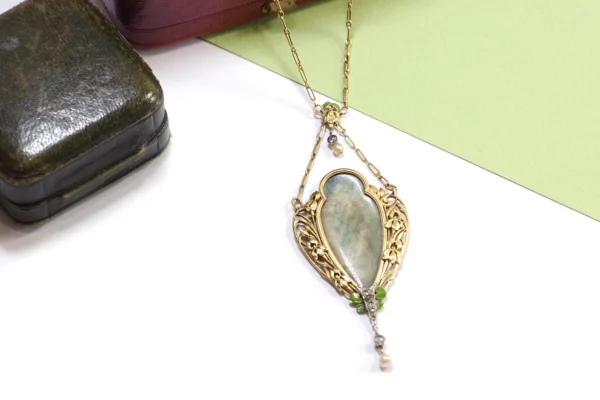
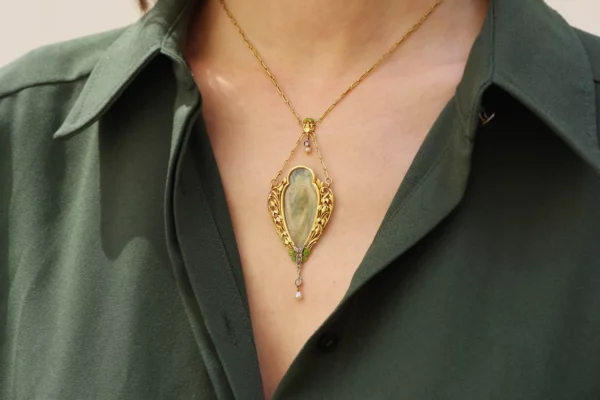 2800,00€
2800,00€French Art Nouveau iris water lilies necklace in 18 karat yellow gold. Lovely Art Nouveau necklace featuring a pendant enclosing a miniature in a frame decorated with irises and water lilies. The miniature depicts a ghostly woman near a satyr-headed fountain. The blue and green colors are partially washed out and faded, giving the whole a mossy agate appearance. The pendant is held by two chains joined by an iris decorated with a rose-cut diamond and a fine pearl. Green varnish highlights decorate the pendant. The lower part is set with rose-cut diamonds and a tassel with diamonds and natural pearls. Art Nouveau pendant, circa 1900, France.
Eagle head and rhinoceros hallmarks (French State hallmark for 18 karat gold)
Total length of necklace: 39.5 cm
Pendant dimensions: 8 x 3.2 cmCondition: partially faded miniature, clasp changed, later green varnish (can be removed with nail polish remover)
Weight : 16.60 gr
*The antique box is not sold with the jewel*
-
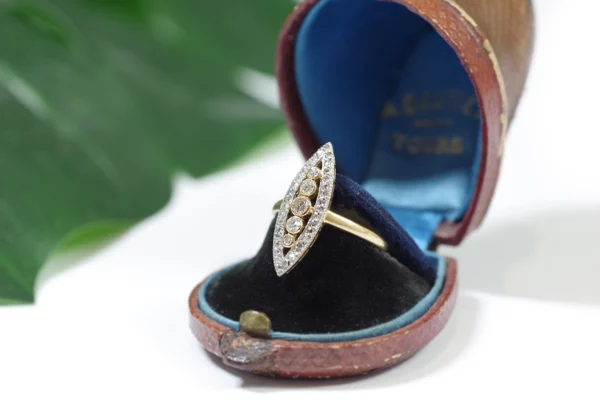
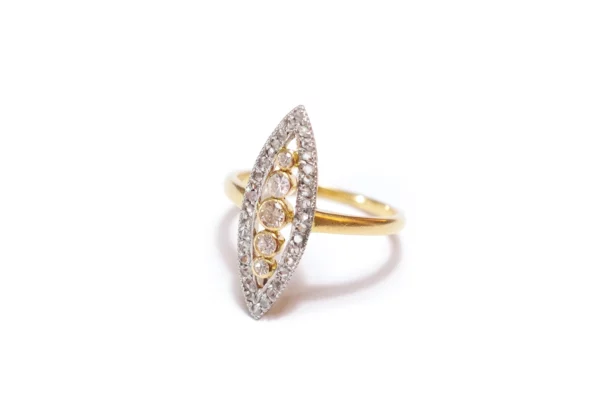 990,00€
990,00€Marquise diamond ring in yellow gold 18 karats and platinum. In the center, a line of 5 diamonds in bezel setting, one more important in the center, surrounded by rose-cut diamonds on platinum. Belle époque navette ring, early 20th century.
Mascaron hallmark, owl hallmark
Finger size : 46 UE or 3,75 US (resizing possible)
Dimensions of the ring head : 20,25 mm x 7.2 mm
Note: the diamonds in the central line are brilliant cut, except for one which is old cut 8-8
Condition : scratches from useEstimated diamond weight : 0,30 carat
Weight : 2,32 gr
*The antique box is not sold with the jewel*
-
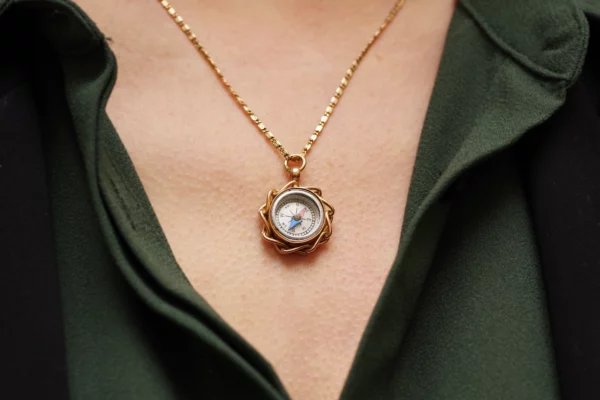
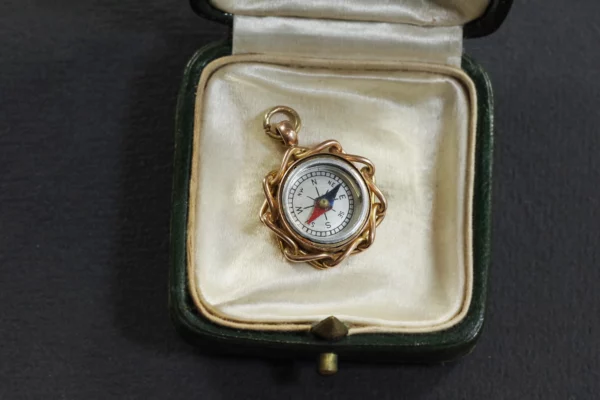 750,00€
750,00€Victorian antique compass pendant in 9 karats gold (375). Lovely compass pendant with an arrow turning on the cardinal points to indicate North. It is protected by glass. The compass is decorated all around with a gold chain motif (not flexible). England, Birmingham, 1900.
English hallmarks : Marine anchor (Birmingham), 9, 375, J.T and lower-case letter a (corresponding to the year 1900).
Dimensions: 27 x 19 mm
Diameter: 19 mmCondition: scratches from use
Weight : 4,66 gr
*The antique box and the chain are not sold with the jewel*
See our antique chains -
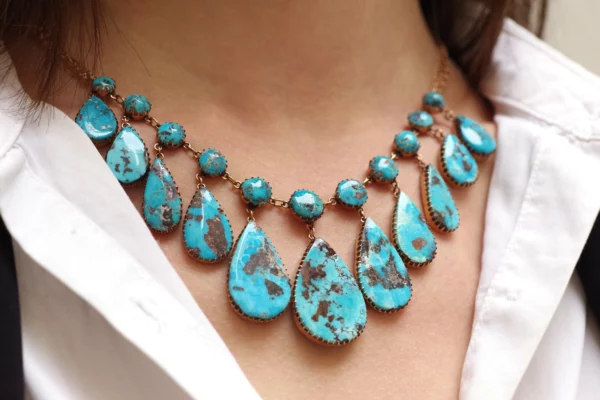
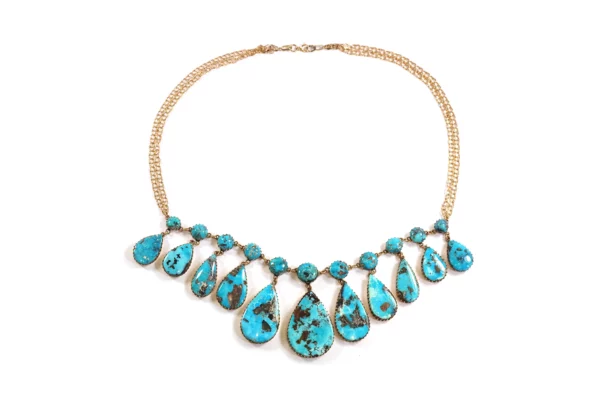 3700,00€
3700,00€Russian turquoise drapery necklace in 14 karat (583) rose gold. Drapery necklace composed of eleven drop-shaped turquoise plaques on matrix (visible on back), topped with round cabochons. The necklace is finished with a double chain of flat links. The turquoise may have come from Kazakhstan, a country under Russian rule since the 17th century, where turquoise mines are still found, but more likely from Persia, which supplied countries and courts with its beautiful, intense-blue stones. Turquoise from Kazakhstan is generally blue with a hint of lavender inside, suggesting Persian turquoise. Necklace circa 1900, chain changed afterwards.
Shell hallmark, on the chain, certainly changed after the necklace was made: Russian “sickle and hammer” hallmark (active after 1958), SAS or GAS hallmark on the clasp.
Total length: 42 cm
Dimensions of largest drop: 21 x 45 mmNote: The slight difference in gold color between the chain and the necklace suggests a modification of the jewel.
Condition : wears of useWeight : 35.20 gr
About turquoise: Read our article by clicking here.
-
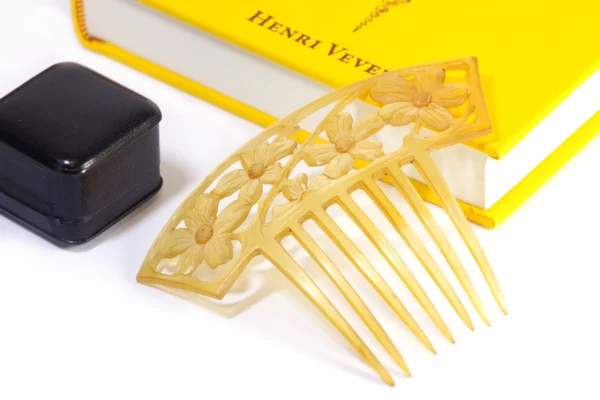
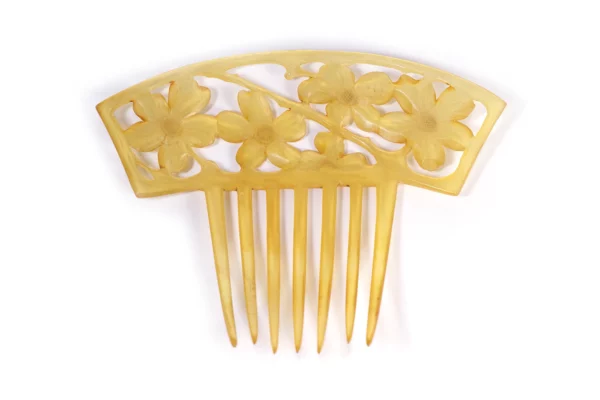 400,00€
400,00€Large Art Nouveau horn comb. Large Art Nouveau seven-tooth comb in blond horn with floral decoration. It depicts a cherry blossom branch, a very common motif in the Art Nouveau period, influenced by Japanese art. Chignon comb signed E. Birkel, circa 1900.
E. Birkel signature.
Height : 10.5 cm
Width : 13.5 cmCondition : wears of use
Weight : 19 gr
